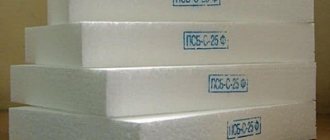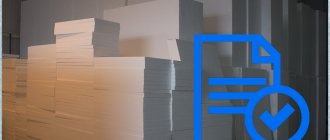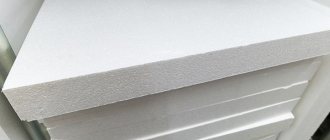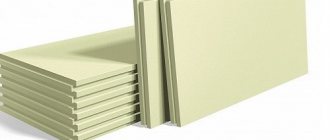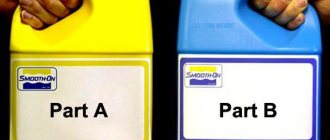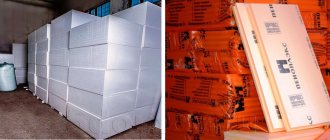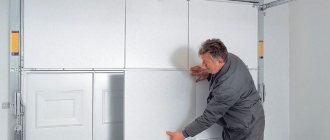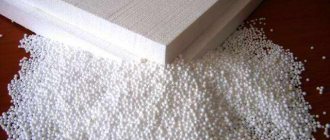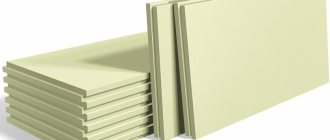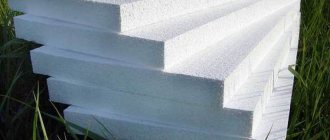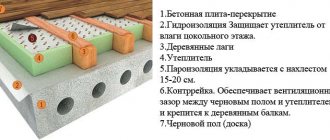To retain heat in a private house or apartment, external or internal wall insulation is performed. It is important that all materials used in the construction or renovation process are environmentally friendly.
For example, polystyrene foam is used as insulation. How safe is it for humans and can it be used for insulation?
Is polystyrene foam as insulation harmful to human health?
Many users, in particular owners of apartments on the upper floors, prefer to carry out thermal insulation work from the inside of the room. What does this mean? Which insulation material should you prefer and what is the difference between polystyrene foam and polystyrene? Is polystyrene foam harmful to human health? If it is dangerous, then why and what are the harmful properties of polystyrene foam?
Is polystyrene foam as insulation harmful to human health? What the experts say
Of course, we would like all our reasoning to be supported by the opinion of people who do research.
Roman Eberstaller, Austrian production manager says:
“In Europe, expanded polystyrene has been used for almost half a century. During this time, no one has yet surpassed this material in terms of environmental friendliness and efficiency, because it is used in construction and thermal insulation and for packaging food, medicines and fragile items... European consumers often use our material when packaging food and medicine. In these situations, the quality requirements are very high. This is the best evidence that polystyrene foam is not dangerous for nature and humans.”
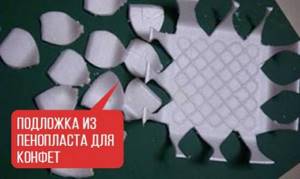
The argument seems convincing, doesn't it? If we are not afraid to take candies from the supermarket shelf that are lying on a foam base, should we be afraid to insulate the wall of our house with them?
“This is the best evidence that polystyrene foam is not dangerous for humans and nature”
As a counterbalancing argument, the following can be given:
- People have invented excellent, economical and, it seems, not harmful plastic. But, the interiors of expensive cars are trimmed with genuine leather;
- People came up with inexpensive chipboards. MDF, but expensive furniture is still made from natural wood.
Did you get the point? All modern technologies are aimed mainly at cost-effective solutions. And this means that the BEST QUALITY remains natural. Expecting eco-friendly linen insulation from polystyrene foam is not entirely fair. But the issue of finance has not been canceled. And expanded polystyrene remains the best in terms of price-quality ratio. This means that decisions must be made taking into account financial capabilities. Unless you carefully chose a place on the planet to live, read books on nutrition, and don’t exercise every day, it’s unlikely that foam insulation will be your family’s worst enemy. If you are sensitive and even pedantic about your health, perhaps you should focus on choosing a more natural insulation. Although the conversation about the harmfulness of polystyrene foam could be continued, there are already plenty of thoughts to think about.
Please remember the example about children at the beginning of the article. Now it is clear to us that the harm of polystyrene foam is not a child’s issue. And yet we have principles and facts that are sufficient to make a decision about our own home.
On video
Some properties of penoplex are shown below. In it, the guys conclude that penoplex is not harmful to health. But, when melted, its toxicity is, of course, unambiguous.
At what temperature does foam release phenol? Is foam insulation harmful?

Damage to polystyrene foam in residential areas
In order to save at least a little heat longer, people insulate their homes inside and outside, without thinking about the dangers of some materials used for these purposes. Very often, for example, foam plastic is used as such materials. How safe is it for internal and external thermal insulation of walls, does it cause any harm to human health and the environment?
Considering the main composition of polystyrene foam, which is styrene, formaldehyde and phenol, you should carefully weigh all the pros and cons of insulating a house with this heat insulator. When the temperature rises above 25 degrees, low-quality materials can release harmful substances that pose a health hazard.
What is foam made of?
As mentioned above, the main components in the manufacture of polystyrene foam are:
- Styrene - as the temperature rises, styrene begins to release. It is a harmful substance to human health;
- Formaldehyde or, as it is also called, methanal, “formaldehyde” is a highly toxic substance that can also be released when exposed to high temperatures;
- Phenol is a chemical substance that poses a certain danger to human health. Phenol is activated by direct exposure to sunlight, as well as by elevated temperatures.
All of the listed substances that are in polystyrene foam can accumulate indoors, thereby having a negative effect on the human body.
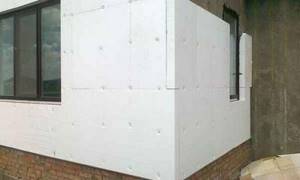
At the same time, it is worth understanding that there are products (foam plastic) certified and tested by the manufacturer, which have passed full control and testing, and there is a craft product at a greatly reduced price. In certified thermal insulation materials, the content of all of the above harmful substances is reduced to a minimum, so such materials do not pose a particular threat to humans and the environment.
How harmful is foam insulation?
When insulating a house externally, polystyrene foam does not cause any harm to a person or his life. However, as for the internal insulation of walls with polystyrene foam, it is worth thinking about the harm. As mentioned above, when heated, foam can release harmful substances into the air. Therefore, many are convinced that the harm of polystyrene foam depends, first of all, on the location of its installation (see).
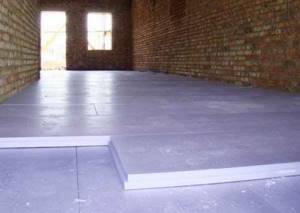
In order to completely eliminate the harmful effects of polystyrene foam on health, if you are not confident in the high quality of the thermal insulation material, you should:
- Limit wall insulation with foam plastic indoors;
- Insulate only the outer walls of the house with this material;
- If you need to insulate the ceiling with foam plastic, then, if possible, install it from the attic side. You should also not insulate the balcony;
- You cannot buy homemade foam plastic that does not have a certificate. You should always remember that the amount of harmful substances in counterfeit thermal insulation materials can be an order of magnitude higher;
- To avoid harm to polystyrene foam, it should be used only for its intended purpose, namely, for external insulation.
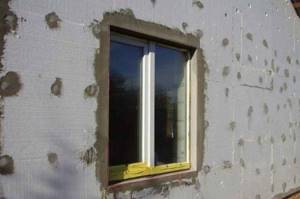
Sometimes rumors about the dangers of certain materials are unjustified. Manufacturers of building materials are constantly striving to improve their products and make them safer to use. Moreover, each purchased building material must have an appropriate safety certificate, which confirms its safety in human use.
Myth 3 Expanded polystyrene breaks down quickly
Expanded polystyrene is not resistant to high temperatures, and its structure is destroyed already at 30 ° C.
There is a method for determining durability, based on a cyclic change in temperature from +40 °C to −40 °C with aging in water. Each such cycle is taken to be equal to 1 conventional year of operation. Using this method, high-quality building grades have a durability of at least 50 years.
For mechanochemical destruction to begin, it is necessary to heat the foam to 160 C. When the temperature rises to +200 C, thermal oxidative destruction begins. Above +260 C, depolymerization begins, decomposition to the original monomer - styrene.
This also includes the myth about the fragility of this material: expanded polystyrene cracks, crumbles, and loses its heat-insulating properties after 7-8 years. Manufacturers provide a 25-year warranty.
Yes, indeed, if the surface is not properly insulated with plaster solutions, the foam can quickly become saturated with water, which leads to a sharp drop in thermal insulation properties, and with cyclic exposure to negative temperatures, lead to rapid destruction
That’s why it’s so important to follow technological regulations
Polystyrene foam poisoning. Is polystyrene foam as insulation harmful to human health?
To retain heat in a private house or apartment, external or internal wall insulation is performed. It is important that all materials used in the construction or renovation process are environmentally friendly.
For example, polystyrene foam is used as insulation. How safe is it for humans and can it be used for insulation?
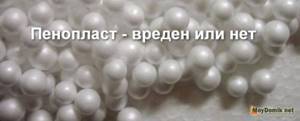
Is polystyrene foam as insulation harmful to human health?
Many users, in particular owners of apartments on the upper floors, prefer to carry out thermal insulation work from the inside of the room. What does this mean? Which insulation material should you prefer and what is the difference between polystyrene foam and polystyrene? Is polystyrene foam harmful to human health? If it is dangerous, then why and what are the harmful properties of polystyrene foam?
What harmful substances does foam release?
To determine whether polystyrene foam emits harmful substances, you need to consider the composition of the foam; among the harmful components it includes:
- styrene (0.01-0.2%) is a substance harmful to human health that can be released into the air for another 20 years after installing the insulation. Released when the temperature exceeds 25 °C;
- phenol is another chemical compound in foam that is released when exposed to direct sunlight or at temperatures exceeding 20 ° C;
- formaldehyde (formaldehyde, methanal) is a toxic gaseous substance that is released at high temperatures (over 160 ° C).
It should be remembered that substances released by polystyrene foam tend to accumulate, causing deterioration in the health of people living in the room.
So, on the one hand, the balance is: ease of installation, convenience of further finishing, low cost, and on the other hand, the safety of the house and its occupants.
Is polystyrene foam harmful as insulation?
It is possible to answer unequivocally only taking into account the location of its installation and operating conditions, in particular the temperature regime.
When talking about the harmfulness of polystyrene foam, you need to consider at what temperature the foam releases harmful substances. As already noted, styrene and phenol are released at room temperature.
Many are convinced that the harm of polystyrene foam manifests itself regardless of the installation location. However, is foam plastic harmful indoors or is there no health risk when installing it on interior walls? Experts say that polystyrene foam installed on external walls is absolutely safe, since the small amount of vapors of harmful substances that can penetrate through the ventilation, even if accumulated, cannot cause significant harm.
How to eliminate the harmful effects of polystyrene foam
You can reduce or neutralize the harm of polystyrene foam as follows:
- do not install in residential premises, inside rooms of a house or apartment;
- when insulating walls in a house, attach polystyrene foam only to external walls and install ventilation correctly;
- if it is necessary to install foam plastic on the ceiling, this should be done from the attic side (provided that it is non-residential). Installation on the balcony ceiling (from the inside) is also excluded;
- do not purchase polystyrene foam produced by handicraft methods. Each seller must have a certificate confirming the styrene content;
- Use only for its intended purpose, namely as external insulation. The construction of playhouses for children is, of course, unacceptable. But is polystyrene foam dangerous for animals and birds, in particular for chickens (who love to peck at it)? Manufacturers say no. After all, the lifespan of chickens is short and harmful substances simply do not have time to accumulate in their bodies.
Temperature characteristics:
| Polystyrene | Operating temperature limits, C | Vicat softening point | Heat resistance according to Martens | Melting point C | |
| upper | lower | ||||
| PS | 65-70 | -40 | 82-105 | 76-82 | 160-175 |
| ABS | 75-85 | -60 | 99-100 | 90-104 | 165-180 |
Dielectric constant of polystyrenes:
| Polystyrene | έ at v, Hz | ||
| 50 | 103 | 106 | |
| PS | 2,65 | 2,6 | 2,6 |
The flammability index (K) is a dimensionless quantity that expresses the ratio of the amount of heat released during combustion to the amount of heat expended on igniting a sample of material. Material with index K>0.5 is flammable. For polystyrene, the K-1.4 indicator is flammable
Penofol is harmful to health. Penofol - pros and cons
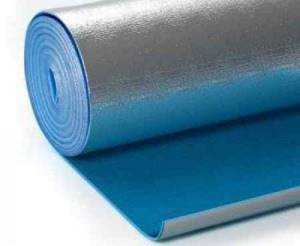
Penofol - pros and cons of use
Among all the variety of insulation materials today, penofol takes its rightful place. This is due, first of all, to its high thermal insulation and reflective qualities, as well as its absolute harmlessness to humans.
Indeed, penofol is non-toxic, has very low weight and excellent thermal insulation properties. They can easily insulate both the external and internal walls of a house, without fear of the formation of fungus and mold under the insulation. By the way, the ceilings are also simple, you can read in the previous article.
Penofol - pros and cons
The advantages of penofol compared to other insulating materials are obvious. And they are associated, first of all, with the good performance properties of penofol. If we briefly consider the main advantages of this insulating material, they are as follows:
- In terms of environmental friendliness, since only food grade foil is used in the production of penofol, its harmfulness when used is practically reduced to zero. According to unverified data, penofol even has the ability to protect against radiation.
- Excellent thermal insulation properties make penofol a high-quality insulating building material. You should not think that if penofol is thinner than polystyrene foam or one layer of mineral wool, then it is not able to completely replace them.

It has been verified that penofol 4 mm thick with double-sided foil can replace polystyrene foam 3 cm thick or mineral wool with a layer thickness of 8 cm. These are indeed excellent thermal insulation properties, which make it possible to use penofol when insulating even the external walls of a house.
- The low vapor permeability of penofol makes it possible, when insulating the walls of a house with it, to refuse an additional layer of vapor barrier materials. This, in turn, allows you to slightly reduce the financial costs of insulation work.
- The ease of installation of penofol makes it possible to easily install the material with your own hands, without involving professionals for these purposes.
- Fire safety - this type of insulation material belongs to the class of low-combustible building materials.
As you can see, the advantages of penofol are obvious, but, unfortunately, it also has disadvantages.
Disadvantages of penofol
The disadvantages of penofol are primarily associated with its insufficient hardness, which is why it is absolutely not suitable for plaster, for example, or wallpaper. In other words, if you insulate the walls inside a house with penofol, you will need to assemble a sheathing, which will then need to be sheathed with plasterboard or other finishing material.
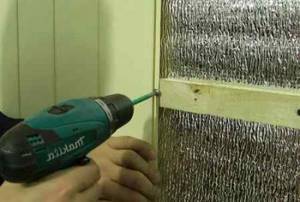
Also, the disadvantages of penofol include some difficulties associated with its installation. The material is quite difficult to attach to the wall surface. The only exception to this is penofol with a self-adhesive film, the installation of which is greatly simplified by the presence of a sticky surface on the other side.
Well, the last thing, although it was said above that polystyrene foam can be used to insulate the external walls of a house, the same polystyrene foam or polyurethane will cope much better with this. Here, penofol is most often used as an additional layer, which ensures reliable reflection of moisture and abundant heat from the surface of the walls.
Myth 4. Expanded polystyrene is eaten by mice and rats
In fact, this plastic does not attract rodents as food, just like any other hydrocarbon. For them, this is just an obstacle on the way to food and water. They gnaw passages in it, arranging homes. Rodents will chew any material that is an obstacle for them. It’s just that the porous structure cannot withstand their sharp teeth, like any porous insulation.
To prevent rodents from becoming a serious problem, it is enough to constructively close access to thermal insulation. It has been experimentally established that for the construction of nests, mice and birds will choose foam granules last after fiber materials, that is, glass and mineral wool.
Allergy to polystyrene foam. Harm No. 4: vapor barrier

This cannot be called a strong danger. However, there can still be a negative impact.
What exactly are we talking about? The fact is that the vapor permeability of polystyrene foam is very low, almost equal to zero. Simply put, this material “does not breathe.” And if it “breathes,” it’s very bad. And, for example, when walls made of “breathable” materials (wood, clay, brick) are insulated, you can very quickly notice a negative impact.
Due to the polystyrene foam, it will be very difficult for water vapor to escape from the premises through the walls to the street. That is, the walls will begin to “breathe” poorly. This means that if the house does not have a good ventilation system, the microclimate in the premises can noticeably deteriorate. Over time, the humidity level in the rooms will increase and become uncomfortable.
Naturally, this will create a negative impact on the health of the people living in the house. First of all, it will affect the respiratory system.
In addition, due to the gradually accumulating moisture in the thickness of the wall, the service life of them and the entire house as a whole can significantly decrease. That is why many experts strongly advise that if foam plastic is used for insulating houses, then only those where the walls are made of materials with almost zero vapor permeability (for example, concrete). In these houses, the walls “breathe” very poorly anyway, so polystyrene foam will not create any vapor barrier. The removal of vapors and a comfortable microclimate in such houses are ensured precisely due to the operation of the ventilation system. Naturally, we are talking about external insulation.
